Introduction
Avenues is a project that tackles the issue of poor air quality in Barcelona. Even though pollution is mainly a by-product of fossil fuel emissions and other human activities, weather determines air quality on a given day more than any other factor. The project research looks at this interplay of weather variables and urban morphology that determines the quality of the air we breathe.
Research
Cities worldwide are suffering from poor air quality. There are many sources that contribute to polluted air and many adverse effects that stem from it. A report from the World Health Organization states that “In 2012, one out of every nine deaths was the result of air pollution-related conditions. Of those deaths, around 3 million are attributable solely to ambient which is outdoor air pollution.” The movement of pollutants in the atmosphere is caused by transport, dispersion, and deposition. Transport is a movement caused by wind flow. Dispersion results from local turbulence whereas deposition processes, including precipitation and sedimentation, cause downward movement of pollutants in the atmosphere.
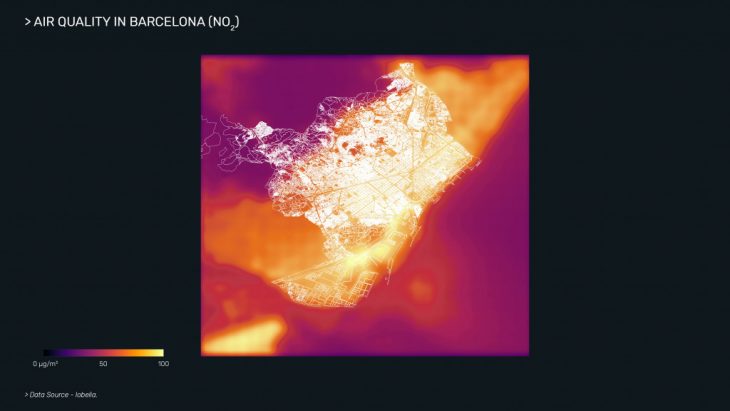
Our project focuses on air pollution present in urban areas, specifically Barcelona. A guiding force in the work and direction of this project is the work done by Lobelia on modeling NO2 concentrations in cities including Barcelona. Their model combines observations, satellite, and traffic data, among others.
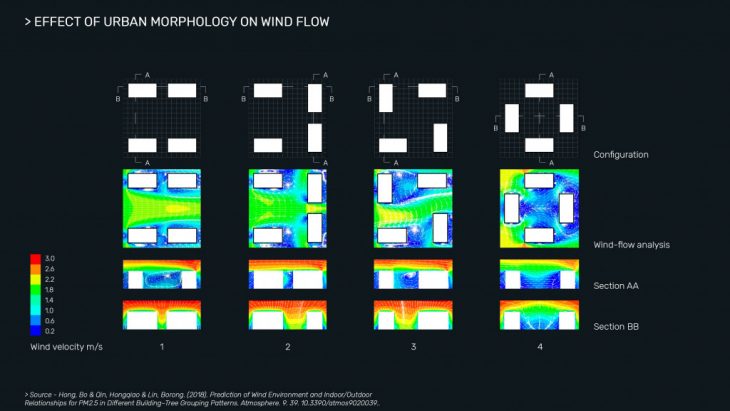
Studies addressing pollutant dispersion in relation to urban geometry shows that urban ventilation is depending on how the urban street grid is orientated to the prevailing wind directions. As a rule of thumb, urban ventilation is beneficial if there are pollutants emitted inside the canyon, for instance from traffic. Which is the major source of air pollution in Barcelona. The difference in building height also influences the mixing of pollutants with clean air.
Analysis
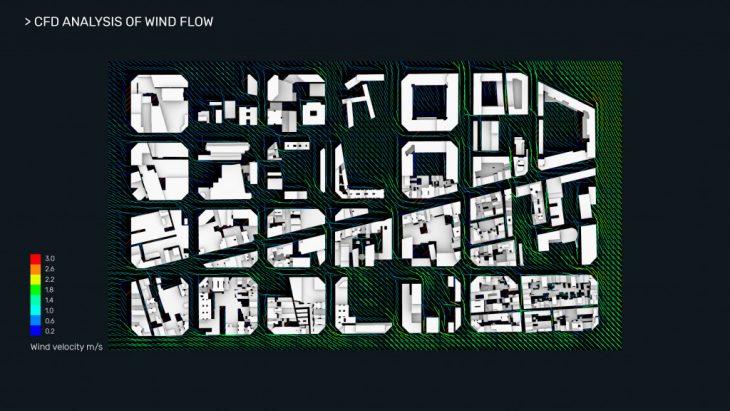
It is necessary to be able to protect the city from high pollution concentration. To know the consequences of urban building design, Computational Fluid Dynamics (CFD) simulations can be used to analyze how the geometry influence the wind flow around buildings. In our case, we use CFD to analyze wind flow on our chosen site of 28 blocks in the district of Sant Marti.
What we observe from our analysis is that the grid plan of Barcelona creates urban canyons that modify both the speed and direction of the wind. When the air flows into this configuration, it naturally adopts the new boundary conditions. The resulting flow inside the canyon depends on whether the street is parallel or perpendicular to the wind. When the wind direction is parallel to the street, a channelization effect is seen which increases the dispersion of pollutants inside the street canyon. When the wind direction is perpendicular to the street, vertically rotating wind flow is created which confines airflow, reduces the dispersion of pollutants, and increase the pollution concentrations inside the street canyon.
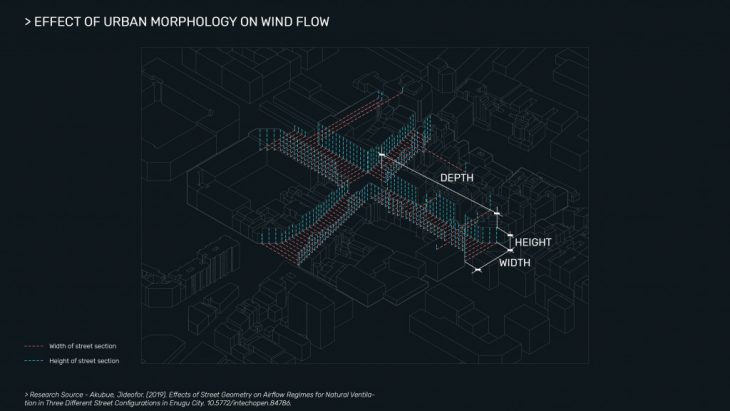
Based on the aspect ratio of the canyon, different flow regimes are formed. In the case of street canyons perpendicular to the street, these flow regimes are isolated roughness flow, wake-interference flow, and skimming flow. The airflow inside these develops in two regions, one where the air is continuously recirculated and other which is a ventilated region.
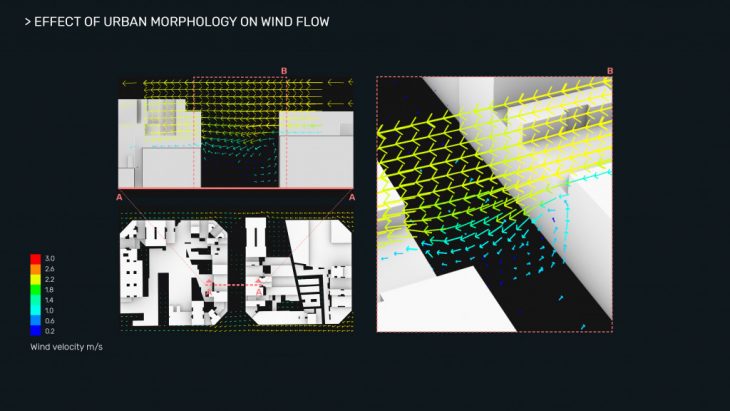
By using CFD simulation we are able to determine the parameters that lead to recirculating wind flow within our site that causes pollution concentration. What we also find is a range of ideal wind conditions that flush out pollutants in the street canyons. This combined with the diverse aspect ratios of the street canyons gives us a rule set. The rule set is based on the characteristics of nearby building conditions. This ruleset is created to overcome the limitations of time and resource-consuming CFD simulations.
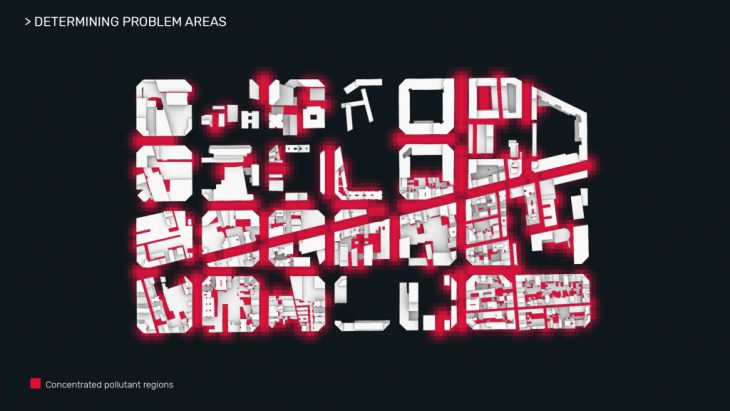
The purpose we take into account annual aggregated data to determine all potential problem areas. With this, we are able to locate a building that blocks the wind flow to these areas. Our project proposes to create porosity in these highlighted buildings to mitigate the issue of poor ventilation. This can also be computed in real-time using instant data so that we can actively control the wind flow and thereby the ventilation of outdoor spaces. Based on our analysis, Eli will further illustrate our design proposal.
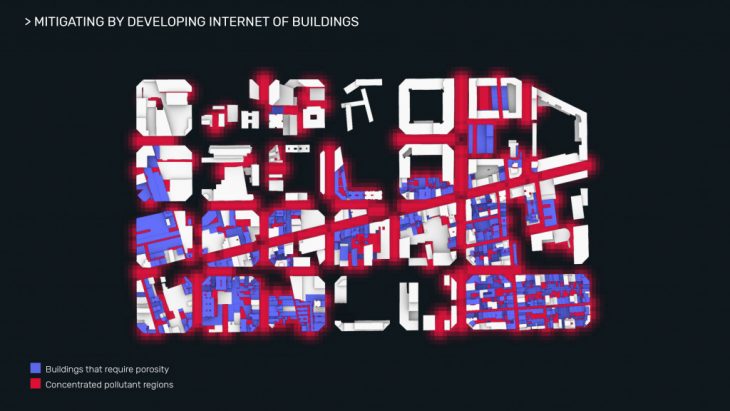
Design Proposal
De-massing the entire building is a brash approach. This is where we can introduce a design element. This design must find a medium between removing building parts and maintaining spaces within. This design, as an added benefit, will be adaptable because our analysis resulted in a program that outputs where to de-mass given current wind and pollution conditions. An adaptive mesh satisfies these needs. This mesh will inhabit critical intervention areas and change the state, responding to where the wind is coming from and where poor ventilation is present. This structure allows for unique opportunities on the ground floor such as informal public space, galleries or exhibitions, a venue whose table arrangement mirrors the concept of directing chaos to order. And although some interior floors are sacrificed, these spaces have the opportunity to be temporarily extruded and occupied either on a nightly basis or during situations such as the lockdown where pollution from traffic is not a major concern.
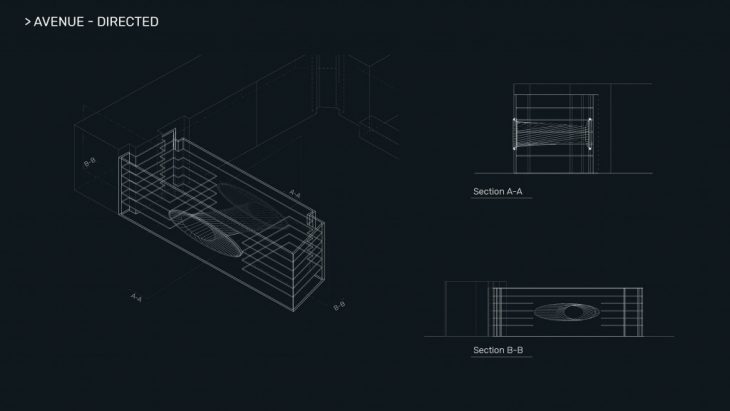
Conclusion
Thankfully we are moving towards more sustainable resources. We are well aware that cutting emissions at the source is the most cost-effective option but our skillset enables us to contribute (to the problem of poorly ventilated cities) in this manner. This solution confronts air pollution in an alternative way and does not require enormous cultural and industry-changing shifts. Rather, avenues allow cities to gradually reach their goals, one by one, with a node-based solution, which can build to create an internet of buildings.
Credits
Avenues is a project of IaaC, Institute for Advanced Architecture of Catalonia
developed at Master in City & Technology in (2019/2020) by:
Students: Elijah Munn, Kushal Saraiya
Faculties: Areti Markopoulou, Alex Mademochoritis, Iacopo Neri